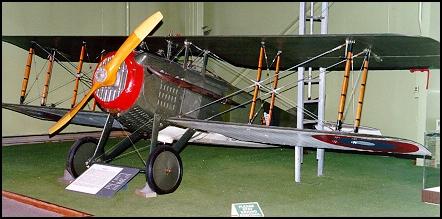|
The Spad VII, a French designed fighter
airplane, made its initial flight in July 1916. It showed such promise that
it was put into production at once, and by the latter part of 1916 it began
to appear on the front in both French and British combat squadrons. The
airplane was an immediate success, primarily because of its structural
ruggedness which permitted it to dive at high speeds without disintegrating. The famed Lafayette Escadrille was using the Spad VII in
February 1918 at the time it transferred from the French Aviation
service to the Air Service, American Expeditionary Force
(A.E.F.), and became the 103'd Aero Squadron.
Several other U.S. units also used the Spad VII, although most A.E.F. fighter squadrons were equipped with a slightly improved version, the Spad XIII, by the time the war ended in November 1918. Slightly more than 5,000 Spad VII's were built, of which 189 were purchased by the A.E.F. This airplane was obtained from the Museum of Science and Industry, Chicago, Illinois, and restored and flown by the 1st Fighter Wing, Selfridge AFB, Michigan, 1962-1966. |
 |
|
|
SPECIFICATIONS Span: 25 ft. 8 in. Length: 20 ft. 3 in. Height: 7 ft. Weight: 1,550 lbs. maximum Armament: Vickers .303-cal. machine guns Engine: Hispano-Suiza 8-Aa of 180 hp. PERFORMANCE Maximum speed: 127 mph. Endurance: 2 1/2 hours Service Ceiling: 17,500 ft.
|
||